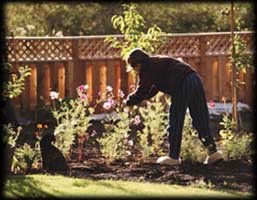 By Judy Staber
By Judy StaberFor the past two weeks I have been weeding our front flower bed. It is a long and fairly narrow bed and over our fifteen-year marriage we have introduced various perennials, flowering shrubs, and one handsome blue spruce which was once a Christmas tree.
Many of the plants in this bed were wedding presents, so it is
 by way of being a friendship garden, in fact we refer to the plants by the giver’s name as in “Bea Snyder is looking very well and spreading out nicely” (Bea is a Creeping Juniper) or “Do you think Polly is dead?” “No, she always leafs out late” (dear Polly’s a Sweet Pepper Bush).
by way of being a friendship garden, in fact we refer to the plants by the giver’s name as in “Bea Snyder is looking very well and spreading out nicely” (Bea is a Creeping Juniper) or “Do you think Polly is dead?” “No, she always leafs out late” (dear Polly’s a Sweet Pepper Bush).Last summer this garden, which was our pride and joy, was not looking so good. It was over stuffed and some plants looked sickly. The culprit we discovered was Aegopodium podagraria, more commonly known as Goutweed, or Bishop’s-weed. (Podagraria is Latin for Gout in the Feet - most fitting)
Now, you can buy Aegopodium podagraria as a ground cover from reputable nurseries. The variegated variety is actually quite pretty -- but not in my garden! If you look amongst the wild phlox, chicory and poison ivy, you can see it along our roadsides. In early summer, its trifoliate leaves are topped by tiny white flowers. My gardening book says it can be controlled by mowing, and to “take root cuttings in the fall.” Never do this, never!

This is an insidious plant. Oh, it may be all right along the roadside, or even on the edge of the lawn, but keep it well away from your flower beds for it has long, white, creeping rootstock that will snake its way around your perennials and throttle them. It is to be found to my cost and my aching back, at great dirt-depths and everywhere you don’t want it to be. You cannot kill it with RoundUp because then you run the risk of killing any adjacent plant, and believe me, Aegopodium makes very sure that it is adjacent to everything in the garden.
We had it everywhere. We had not been diligent over the years, and what had started as a pretty leaf or two like a rumor had spread like wild-fire. The only way to be rid of it and to save our well-established perennials from being choked to death was to just dig up the whole damn garden bed -- except the trees, of course.
And so we began. One by one we carefully dug up and divided the peonies, the phlox, the lilies, the daffodils, the crocuses, the primroses, the hosta, the iris, the astilbe, the echinacea, the Maltese Cross and more. Each plant had to be carefully inspected to make sure no sign of that particular radicle root or trifoliate leaf was intertwined in its roots. Then we planted them temporarily either in other “clean” garden beds or in holding troughs, to be reset once the scourge was gone.
When that was done, John being away, I was left to take down the low rock wall and pull out those damn roots, to carefully dig around the trees and, trying not to disturb their roots, remove as much as I could of this noxious weed.
Plants that were too invaded with this scourge I heaved into the wheelbarrow and planted along our roadside: hostas, iris and day lilies all with close-knit tubers and hardy enough to ignore that snaking root in their midst. They are doing well and promise blossoms in their new habitat.
Now I am deep forking over the empty bed finding rocks and ever more of the weed. I often resort to lying down in the dirt with a hand hoe and carefully yanking it out, trying to leave no piece behind. Impossible! Then I gather the bits of root into a bucket. How many buckets of Aegopodium podagraria have been dumped deep into our woods? I have lost count. I could have made a fortune selling it -- but I wouldn’t wish it on any unsuspecting gardener.
As I lie in the now empty bed, I’ve been thinking about the insidiousness of this root. To me it is like the manifestation of unpleasant memories. No matter how hard I try to not dwell on things that have happened to depress me, that remind me of sad times, or make me think uncharitable thoughts; like this root, I’ll never get rid of them completely. There will always be a little bit of root, buried somewhere, and unless I keep an eye out for it, it will take over again.
After 28 years in arts management, Judy Staber retired last year to write and tend her garden. Born into a theatrical family, she grew up at The Actors' Orphanage in England. She has written a memoir about her childhood and is currently working on a biography of her mother and father and their lives in the theater in England and America.
No comments:
Post a Comment